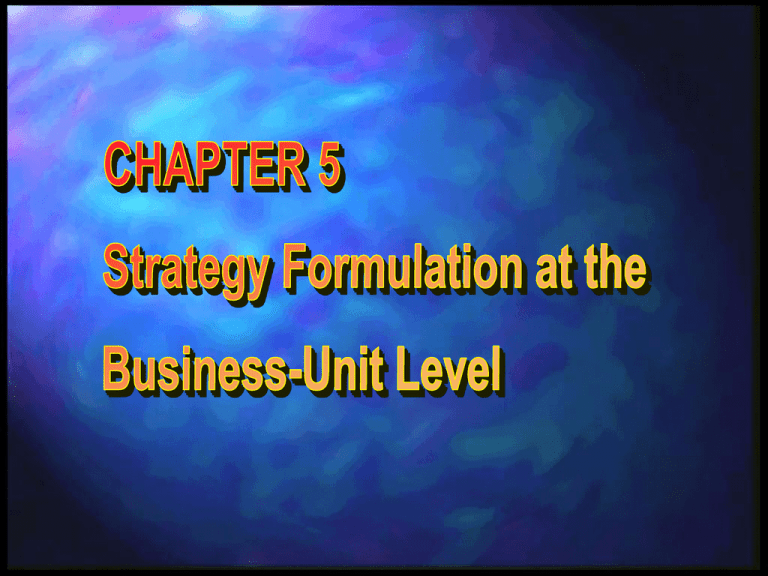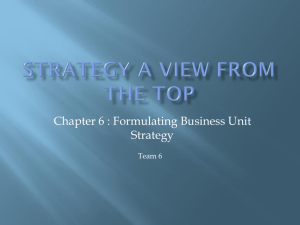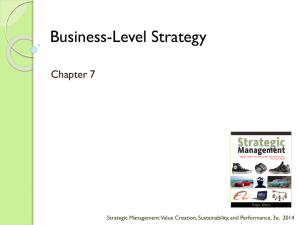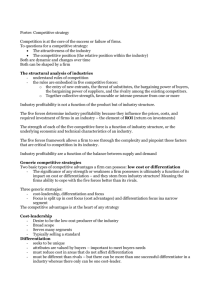
Copyright © 2005 John Wiley & Sons, Inc. All rights
reserved. Reproduction or translation of this work
beyond that permitted in Section 117 of the 1976 United
States Copyright Act without the express written
permission of the copyright owner is unlawful. Request
for further information should be addressed to the
Permissions Department, John Wiley & Sons, Inc. The
purchaser may make back-up copies for his/her own use
only and not for distribution or resale. The Publisher
assumes no responsibility for errors, omissions, or
damages, caused by the use of these programs or from
the use of the information contained herein.
Learning Objectives
• Understand the responsibilities of a businessunit manager
• Evaluate the effectiveness of a generic
business-level strategy
• Analyze an industry to determine its stage in
the life cycle. Understand how that stage
determines the appropriateness of various
business strategies
• Appreciate the competitive dynamics found in
industries
• Be able to select an appropriate competitive
strategy based on the competitive
environment
Business-level Strategy
Formulation Responsibilities
• Direction Setting
› Establishment and communication of mission, vision,
values, long-term goals of a single business unit
› Creation and communication of shorter-term goals
• Analysis of Business Situation
› Compilation and assessment of information from
stakeholders, broad environmental analysis and other
sources
› Internal resource analysis
› Identification of strengths, weaknesses, opportunities,
threats, sources of sustainable competitive advantage
Business-level Strategy
Formulation Responsibilities
• Selection of Strategy
› Generic approach to competition—cost leadership,
differentiation, focus or best value
› Strategic posture—specific strategies needed to carry out
the generic strategy
• Management of Resources
› Acquisition of resources and/or development of
competencies leading to sustainable competitive
advantage
› Ensure development of functional strategies and an
appropriate organizational design (management
structure) to support business strategy
› Develop control systems to ensure that strategies remain
relevant and that the business unit continues to progress
toward its goals
Generic Business-level Strategies
Strategy
Broad/Narrow
Market
Source of Advantage
Low Cost
Leadership
Broad
Lowest Cost Production
Differentiation
Broad
Preferred Product or Service
Best Value
Broad
Low Cost & Highly Desirable
Product or Service
Focus through
Low Cost
Leadership
Narrow
Lowest Cost Production
Focus through
Differentiation
Narrow
Preferred Product or Service
Focus through
Best Value
Narrow
Low Cost & Highly Desirable
Cost Leadership
• High Capacity Utilization (combined
with accurate demand forecasting)
• Economies of Scale
• Technological Advances
• Outsourcing
• Learning / Experience Effects
A Typical Learning Curve
unit
cost
total cumulative output
Risks Associated With Cost
Leadership Strategy
• May not detect required product or marketing
changes due to preoccupation with cost
• Investments in plants and equipment may
become obsolete due to technological
breakthroughs
• Large investments cause reluctance to
change
• Competitors may quickly imitate cost-saving
strategies
• May go too far in cutting costs, thus
endangering customers or employees
Differentiation
• Uniqueness may be achieved through many
means. Examples are:
›
›
›
›
›
Product innovations
Superior quality
Superior service
Creative advertising
Better supplier relationships
• The key to success is that customers must be
willing to pay more for the uniqueness of the
product or service than the firm paid to create
it.
Risks Associated with a
Differentiation Strategy
• Customers may be willing to sacrifice
special features due to a high price
• Customers may no longer perceive an
attribute as differentiating
• A source of differentiation may be easy
to imitate. Constant innovation is
necessary.
Best Value Strategy
• A combination of strategic elements from
differentiation and low cost
• Firms can increase sales of an attractive
product or service. Sales increases may lead
to efficiency and thus reduced costs
• Consumers are coming to expect a
combination of high quality and low price
• Technological advances often allow a
company to pursue differentiation and low
cost at the same time
• Many companies are pursuing best value
through an emphasis on quality or speed
Principles of Total Quality
Management
• General
› Get to know the next and final customer
› Get to know the direct competition, and the world-class
leaders (whether competitors or not)
› Dedicate to continual, rapid improvement in quality,
response time, flexibility, and cost
› Achieve unified purpose via extensive sharing of
information and involvement in planning and
implementation of change
• Design and Organization
› Cut the number of components or operations and number
of suppliers to a few good ones
› Organize resources into chains of customers, each chain
mostly self-contained and focused on a product or
customer "family"
Principles of Total Quality
Management
• Operations
› Cut flow time, distance, inventory, and space along the
chain of customers
› Cut setup, changeover, get-ready, and startup time
› Operate at the customer's rate of use (or a smoothed
representation of it)
• Human Resource Development
› Continually invest in human resources through crosstraining (for mastery), education, job switching, and
multi-year cross-career re-assignments; and improved
health, safety, and security.
› Develop operator-owners of products, processes, and
outcomes via broadened owner-like reward and
recognition.
Principles of Total Quality
Management
• Quality and Process Improvement
› Make it easier to produce or provide the product without
mishap or process variation.
› Record and own quality, process, and mishap data at the
workplace.
› Ensure that front-line associates get first chance at
process improvement--before staff experts.
• Accounting and Control
› Cut transactions and reporting; control causes and
measure performance at the source, not via periodic cost
reports.
Principles of Total Quality
Management
• Capacity
› Maintain/improve present resources and human work
before thinking about new equipment and automation
› Automate incrementally when process variability cannot
otherwise be reduced
› Seek to have multiple work stations, machines, flow lines,
cells for each product or customer family
• Marketing and Sales
› Market and sell your firm's increasing customer-oriented
capabilities and competencies.
Source: R.J. Schonberger, "Is Strategy Strategic? Impact of Total Quality
Management on Strategy," Academy of Management Executive (August,
1992), p. 83, used with permission.
Emphasis on Speed
• Reducing Time to Provide Good or Service
› Reduces costs
› Customers happier because they are satisfied more
quickly
• May be accompanied by a flexible
manufacturing system (FMS) or a
simultaneous manufacturing system (such as
C3M at Michelin)
Risks Associated with a Best Value
Strategy
• A Tradeoff Between Risks of Cost Leadership
and Differentiation
› Technological breakthroughs can make the strategy
obsolete
› Risk of imitation
› However,
¤ Unlikely to become preoccupied with cost or
differentiation
¤ Unlikely to take cost cutting too far
¤ Increases likelihood of being able to recover
additional costs associated with differentiation
Focus Strategy
• Can be based on differentiation, lowest cost
or best value
• Key is to provide a product or service that
caters to a particular market segment.
› Must identify segment
› Must assess and meet the needs of the segment better
than competitors (target marketing)
› May also be called a “niche” strategy
Risks Associated with a Focus
Strategy
• Risks depend on whether the strategy is
being pursued through differentiation, lowest
cost or best value as well as:
› The desires of the target market can become similar to
the desires of the whole market, thus eliminating
advantage in catering to the target market
› A competitor may focus on an even more narrowly
defined segment of the market
Competitive Dynamics
• Competitive action and reaction
• Creative destruction
› The inevitable decline of leading firms due to competitive
moves and countermoves
• Competition has been increasing in most
global industries
Strategies that Reflect Competitive Dynamics
• Aggressive Competition
› Exploit ownership of superior resources.
› Overwhelm competitors through a combination of factors
that could include the best products or services, superior
advertising, the lowest production cost, superior design,
the lowest price or the strongest brand name.
• First-mover Advantage
› Invest significantly more time and resources to creating
state-of-the-art products and services than competitors
to protect leadership position.
› Organizational learning capacity is important.
• Collaboration
› Partnerships and alliances with stakeholders to offset the
influence of a powerful rival (defensive strategy).
› Or, if a company is the largest rival, create partnerships
and alliances that will block new competition or hurt
existing competitors (offensive strategy).
Strategies that Reflect Competitive Dynamics
• Threat of Retaliation
› Make it very clear to competitors that a firm will retaliate
against any action that will upset the balance in the
industry.
› The threat must be believable.
› Firms may compete simultaneously in multiple industries
(multi-market competition). Therefore, a firm could
retaliate in another industry.
• Government Intervention
› A political strategy in which the firm hires lobbyists and
creates strong relationships with political leaders or
parties in an effort to influence the “rules of the game”.
• Create Barriers to Imitation
› Many potential barriers exist, including economies of
scale, patents, special relationships with stakeholders
(pre-emptive collaboration), or private information.
Strategies that Reflect Competitive Dynamics
• Strategic Flexibility
› An organization limits investments in fixed capital and
forms joint ventures or subcontracting agreements to
provide a lot of what it needs so that it is in a position to
quickly move in and out of markets.
• Avoid Direct Competition
› Find a niche in which no other organization has interest.
› Don’t compete with the same intensity in the same
geographical markets competitors.
Resources, Industry Structure and
Competitive Actions
Firm A
Resources
Change in
Firm A
Resources
Firm A
Action
New Industry
Structure
Industry
Structure
Firm B
Resources
Firm C
Resources
Firm B
Reaction
Change in
Firm B
Resources
Firm C
Reaction
Time
Change in
Firm C
Resources
More
Actions
and
Reactions
Strategic Group Map of Restaurants and Specialty Dining
Wide
Breadth
of Menu
Offerings
Family
Restaurants
Economy
Denny’s
Waffle House
IHOP
Boston Market
Bob Evans
Fast Food
Family Menu
Family
Restaurants
Upscale
Marie Callendar’s
Perkins
TGI Friday’s
Cracker Barrel
Picadilly
Applebee’s
Casual Dining
Steak and Ale
Red Lobster
Ruby Tuesday
Bennigan’s
McDonald’s
Burger King
Wendy’s
Jack in the Box
Arby’s
Fast Food
Limited Menu
Narrow
Taco Bell
Del Taco
Checkers
Subway
Papa John’s
Low
Casual Dining
Limited Menu
Fast Casual
Limited Menu
Sbarro
Chipotle
Starbucks
Fine Dining
Charthouse
Spago’s
Fine Dining
Specialized
Ruth’s Chris
Morton’s
Olive Garden
Chevy’s
P.F. Chang
Bahama Breeze
Cheesecake Factory
Belihana
Pricing/Quality Image
High
Major Concepts in Chapter 5
• The responsibilities of business-level
managers include establishing strategic
direction for the unit, ongoing analysis of the
business situation, selecting a generic
strategy and posture, and acquiring and
managing resources.
• Cost leadership entails producing products
and services at the lowest possible cost
• Differentiation means attempting to
distinguish products or services so that they
have greater value to consumers
• Best-value strategies combine elements of
low cost and differentiation
Major Concepts in Chapter 5
• Focus strategies entail pursuit of a narrowly defined
market segment through cost leadership,
differentiation or best value
• Organizational dynamics is defined as the moves and
countermoves of competitors
• Strategies that reflect competitive dynamics include
aggressive competition, seeking a first-mover
advantage, collaborative agreements with
stakeholders, threats of retaliation, seeking
government intervention, erecting barriers to
imitation, remaining flexible enough to quickly move
in or out of markets, and avoiding direct competition






